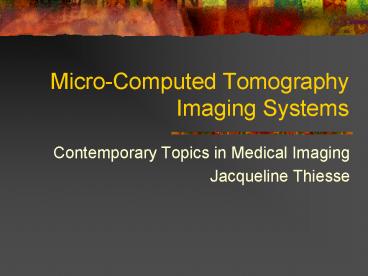MicroComputed Tomography Imaging Systems - PowerPoint PPT Presentation
1 / 20
Title:
MicroComputed Tomography Imaging Systems
Description:
... when accelerated to relativistic speeds in a magnetic field ... Imaging Mouse Models: Emphysema. Micro-CT use in pulmonary imaging research studies ... – PowerPoint PPT presentation
Number of Views:709
Avg rating:3.0/5.0
Title: MicroComputed Tomography Imaging Systems
1
Micro-Computed Tomography Imaging Systems
- Contemporary Topics in Medical Imaging
- Jacqueline Thiesse
2
Outline
- Background Significance
- Recent developments in micro-CT
- Volumetric image formation in micro-CT
- Micro-CT use in pulmonary imaging research studies
3
Background Significance
- Development of sophisticated clinical imaging
techniques - Magnetic resonance imaging
- Computed tomography
- Ultrasound
- Extension of imaging techniques for the research
setting - Micro-computed tomography (micro-CT)
4
What is a micro-CT?
- Mini-size CT scanner
- How is it useful?
- Uses x-ray to create high resolution data sets
through a minimally invasive system. - Sceening small animals for
- Drug discovery
- Cancer detection and monitoring
- Genomics Applications
5
Micro-CTs consist of
- A micro-focused x-ray source
- A specimen
- An x-ray to electronic signal converting imaging
array - A holder that rotates the specimen within a
stationary scanner or rotates the scanner around
the stationary specimen
6
How do we get the resolution?
- Micro-focused x-ray source
- High resolution images come from one of three
methods - Cone beam
- Optical magnification
- Bragg diffraction
7
(Ritman, 2004)
8
Commercially available micro-CT scanners
(Ritman, 2004)
9
Recent Developments in micro-CT
- Reconstruction Developments
- Speed Optimization
- Improving Contrast
- Synchrotron radiation
- K-edge subtraction
- X-ray phase delay
- X-ray fluorescence
10
Reconstruction Developments
- 1981 Feldkamp built scaled down version of a CT
scanner - Used Hermans fan beam algorithm to obtain
volumetric image data - Feldkamp and Davis modified from fan beam to cone
beam geometryreduce time - Helical CT reconstructionnot limited to short
scans
11
Speed Optimization
- Vital when imaging live animals
- Needed to increase throughput when looking at
genomic studies - Use high energy x-ray photon energies
- gt 50 keV
12
Improving Contrast Synchrotron Radiation
- Electromagnetic radiation emitted by high-energy
particles when accelerated to relativistic speeds
in a magnetic field - With synchrotron based imaging high resolution
images are produced using the differences in
refraction and scatter of x-rays that pass
through tissue. - Due to the collimation and monochromacity images
can be recorded at lower doses. - Attempts have been made to create
quasi-monochromatic radiation
13
Improving Contrast K-edge subtraction
- Based on the fact that every element has its own
defined x-ray attnuation value - Must have very narrow spectral bandwidth x-ray to
use this method - Trying to utilize quasi-monochromatic radiation
14
Improving Contrast X-ray phase delay
- Inherent property that x-rays travel at different
velocities through different tissue types - Phase differences are transferred into patterns
based on x-ray intensities and can be
mathematically converted to actual phase delays - 4xs more sensitive than monochromatic
synchronization photon detector
15
Improving Contrast X-ray fluorescence
- Fluorescence created by electron being knocked
out of orbit by x-ray photon and replaced by a
falling electron - Difficult to differentiate the fluorescent
photons from scattered photons
16
Volumetric Image formation in micro-CT
- Feldkamp cone beam reconstruction
- Algorithm consists of three main steps
- Weight the projected data
- Convolve the weighted projections
- Backproject and weight each filtered projection
over the 3D reconstructed volume
17
Volumetric Image formation in micro-CT
18
Micro-CT use in pulmonary imaging research studies
- Imaging Mouse Models Emphysema
19
Micro-CT use in pulmonary imaging research studies
- Imaging Mouse Models Asthma
Kline, 2003
20
Micro-CT use in pulmonary imaging research studies
- Imaging large organ biopsies































